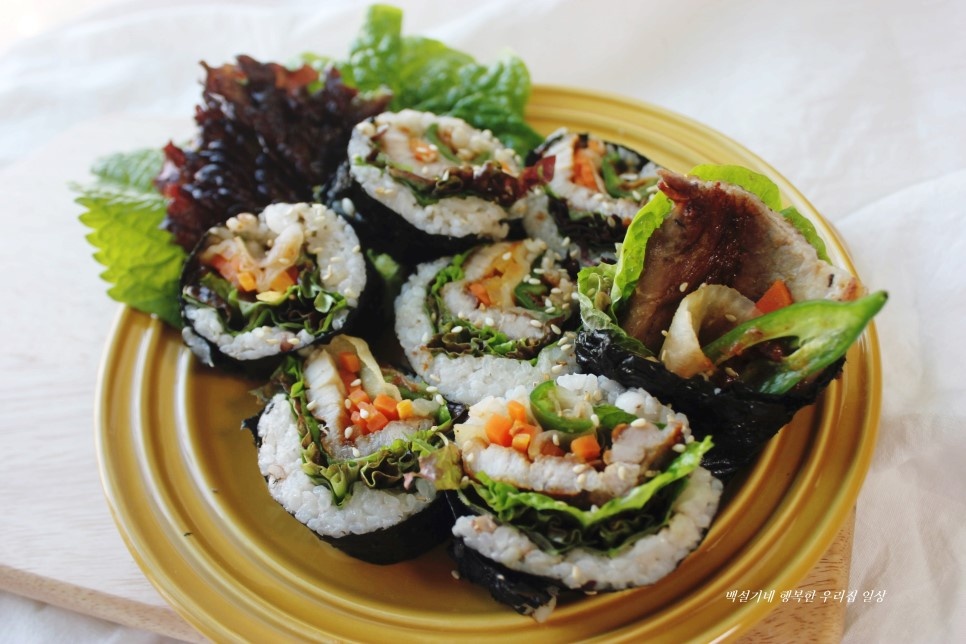GangSikDang Style Pork Belly Kimbap
Flavor Explosion in Every Bite! The Perfect GangSikDang Pork Belly Kimbap Recipe

Watching the popular variety show ‘GangSikDang’ often sparks culinary inspiration! Chef Lee Soo Geun’s Pork Belly Kimbap, in particular, caught my eye. I’ve been so curious about its unique taste and just had to try making it myself. In an era filled with delicious food, being a foodie can be both a blessing and a delicious curse! For someone like me who absolutely must try what they crave, cooking shows are a sweet temptation. I worried it might even appear in my dreams if I didn’t make it, so I decided to dive right in. Come join me and experience the irresistible charm of this Pork Belly Kimbap!
Essential Ingredients- 1 lb Pork Belly
- Kimbap seaweed sheets
- 8 Red leaf lettuce leaves
- 8 Green leaf lettuce leaves
- 8 Perilla leaves
- 4 Korean cucumbers (asahi gherkins)
- 1/2 Carrot
- 12 Pickled radish wraps (ssammu)
- Ssamjang (Korean fermented soybean paste, to taste)
Cooking Instructions
Step 1
First, prepare the pork belly. Lightly season the pork belly on both sides with salt and pepper. Heat a pan over medium heat without any oil, and grill the pork belly until it’s golden brown and crispy on both sides. Ensure plenty of fat renders out for a delicious texture.

Step 2
Peel the carrot, wash it thoroughly, and julienne it into thin strips. Heat a little cooking oil in a pan and sauté the julienned carrots for about 2 minutes. Be careful not to overcook them, as they should retain a slight crunch. Sautéing brings out their natural sweetness, enhancing the overall flavor of the kimbap.

Step 3
Wash the Korean cucumbers, trim off the ends, and cut them in half lengthwise. Remove the seeds from the center. This makes them easier to eat and provides a cavity for the ssamjang. I’ve filled the cucumber halves generously with ssamjang. This method helps prevent the paste from leaking out when rolling the kimbap and ensures a burst of savory flavor with every bite.

Step 4
Cook the rice until it’s fluffy and firm. While the rice is still hot, mix in a little sesame oil and a pinch of salt. Spread a thin layer of the seasoned rice over about two-thirds of a kimbap seaweed sheet, leaving a small border at the top. Be gentle to avoid mashing the rice grains.

Step 5
Arrange the perilla leaves evenly over the rice. Their aromatic scent will beautifully complement the rich flavor of the pork belly.

Step 6
Next, layer the red leaf lettuce leaves over the perilla leaves. This will add a delightful crispness.

Step 7
Follow with a layer of green leaf lettuce. The abundance of fresh greens adds a refreshing element to the kimbap.

Step 8
Evenly distribute the sautéed carrot strips over the lettuce. The vibrant colors are visually appealing, and the carrots’ sweetness balances the other flavors.

Step 9
Now, add the pickled radish wraps (ssammu). These wraps cut through the richness of the pork belly and add a pleasant tanginess.

Step 10
Place the cooked pork belly strips neatly over the other ingredients. While the original GangSikDang recipe used two strips of pork belly, one thick strip is perfectly satisfying. Feel free to adjust the amount based on your preference and the thickness of the pork belly.

Step 11
Finally, add the ssamjang-filled Korean cucumber halves down the center. Don’t be shy with the ssamjang; a generous amount is key to the kimbap’s savory depth. If you didn’t fill the cucumbers earlier, spread a good dollop of ssamjang here.

Step 12
It’s time to roll! Using the bamboo mat, carefully but firmly roll the kimbap, tucking in the filling as you go. Make sure to roll it tightly so it doesn’t come apart, but avoid tearing the seaweed sheet. Starting with a tight tuck at the edge helps create a compact roll.

Step 13
Once rolled, lightly brush the outside of the kimbap with sesame oil for a glossy finish and enhanced aroma. To slice, lightly oil your knife to prevent sticking. Cut the kimbap into bite-sized pieces, ensuring clean cuts so it doesn’t fall apart. Enjoy your delicious Pork Belly Kimbap!



